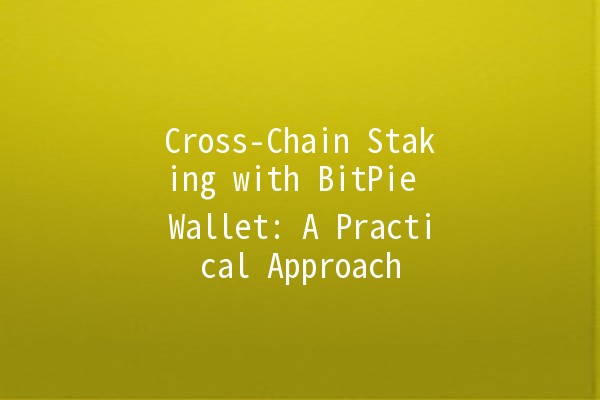
Crosschain staking is becoming an essential aspect of the decentralized finance (DeFi) ecosystem. As the crypto space evolves, so does the need for users to efficiently stake their assets across different blockchains. In this article, we will delve into the realm of crosschain staking using the BitPie Wallet. We will explore the intricacies of the process, offer valuable tips for productivity, and discuss how users can reap the benefits of this innovative technology.
Understanding CrossChain Staking
Crosschain staking enables users to stake their cryptocurrencies on various blockchain networks without being tethered to a single chain. This flexibility allows users to maximize their returns by leveraging opportunities across multiple ecosystems. BitPie Wallet, known for its userfriendly interface and robust security features, supports crosschain staking, making it a preferred choice for many crypto enthusiasts.

Key Features of BitPie Wallet
With these features in mind, let's dive into how one can effectively perform crosschain staking using the BitPie Wallet.
Getting Started with BitPie Wallet
Before embarking on your crosschain staking journey, it's essential to set up your BitPie Wallet. Follow these steps:
Five Productivity Enhancement Tips for CrossChain Staking
Here, we will present five actionable tips to help users improve their productivity while engaging in crosschain staking.
When engaging in crosschain staking, diversifying your portfolio is crucial. This means staking different assets across various chains to minimize risk and maximize potential returns. By spreading your investments, you can take advantage of unique opportunities each blockchain may offer.
Example: Instead of solely staking Ethereum (ETH), consider also staking assets like Polkadot (DOT) and Cardano (ADA) to tap into multiple reward systems.
Staying updated with market trends and developments is vital for making informed staking decisions. Follow crypto news, join community forums, and utilize tools to track price movements and staking rewards.
Example: Use platforms like CoinMarketCap or Messari to keep an eye on changes in staking rewards, potential risks, and network upgrades that could impact your staking strategy.
Many users overlook the benefit of automation in staking processes. Leveraging automation tools can help users streamline their staking activities, reducing manual intervention and ensuring timely actions.
Example: Employ smart contracts that automatically restake your rewards at specified intervals or utilize portfolio management apps that notify you of significant changes.
Joining forums, Telegram groups, or Discord servers related to your staking projects can provide valuable insights and support. Engaging with the community allows you to share experiences and learn from the successes and mistakes of others.
Example: Participate in discussions about upcoming staking opportunities or potential risks associated with certain assets, helping you make wellrounded decisions.
Having clear, achievable goals for your staking can lead to better decisionmaking and motivation. Establish a strategy detailing how much you aim to stake, the duration, and the expected returns.
Example: Set a goal to accumulate a specific amount of cryptocurrency within a year through staking, and regularly monitor your performance against that target.
The Advantages of CrossChain Staking with BitPie
Crosschain staking via BitPie Wallet not only simplifies the staking process but also provides several significant advantages:
Increased Yield Potential: By staking across multiple chains, users can leverage higher rewards offered by specific networks.
Risk Mitigation: Diversifying across various projects reduces exposure to any single blockchain's issues or volatility.
Flexibility: Users are not restricted to one blockchain, enabling them to choose the best staking opportunities available at any given time.
Common Questions About CrossChain Staking
Q1: What is crosschain staking, and why is it important?
Crosschain staking refers to the ability to stake assets on different blockchain networks. It is important because it allows users to maximize their earning potential by exploiting various staking rewards across different ecosystems, enhancing liquidity, and reducing risks associated with locking assets on a single chain.
Q2: How does BitPie Wallet ensure security during staking?
BitPie Wallet implements multiple layers of security, including encryption of private keys, biometric authentication, and regular security audits. Users also maintain control over their private keys, reducing the risk of thirdparty breaches and ensuring that their assets remain secure.
Q3: What types of cryptocurrencies can I stake using BitPie Wallet?
BitPie Wallet supports a variety of cryptocurrencies suitable for staking, including but not limited to Ethereum (ETH), Polkadot (DOT), Cardano (ADA), and Tezos (XTZ). The list of stakeable assets may expand as the wallet evolves, allowing users to access new opportunities.
Q4: Is there a minimum amount required for staking via BitPie Wallet?
The minimum staking amount can vary depending on the blockchain and asset selected for staking. Some networks may require a minimal stake, while others do not. It is advisable to review the specific staking requirements for your chosen assets within the BitPie Wallet.
Q5: How are staking rewards distributed?
Staking rewards are typically distributed at regular intervals, depending on the blockchain's protocol. These rewards can be automatically reinvested (restaked) or withdrawn to the user's wallet based on their preferences and the wallet features provided.
Q6: Can I unstake my assets at any time?
The ability to unstake assets varies between blockchains. Some networks may allow immediate unstaking, while others have a cooldown period before assets can be withdrawn. Refer to the specific blockchain's rules to understand the conditions regarding unstaking.
Crosschain staking using the BitPie Wallet presents an exciting opportunity for cryptocurrency enthusiasts to enhance their staking experience. With the ability to diversify, automate, and engage with the community, users can effectively boost their productivity and returns. By following the outlined strategies and best practices, individuals can navigate the challenges and enjoy the benefits of crosschain staking in this dynamic ecosystem. As the DeFi landscape continues to expand, adapting to emerging trends will be key to longterm success in digital asset management.

